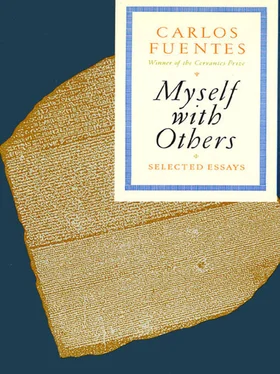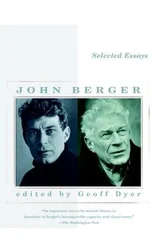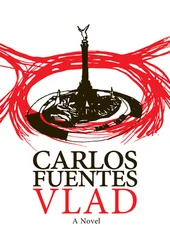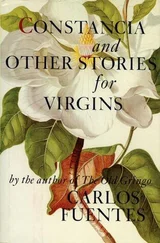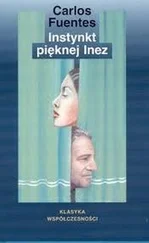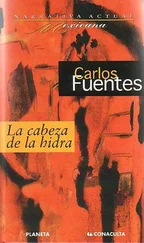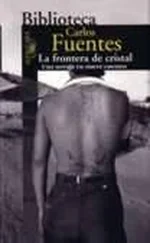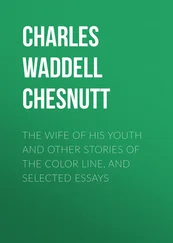Again, the grand Spanish myth of Don Juan is traversed and frustrated: in Buñuel, Don Juan’s ladies are one step ahead of the male conquistador — they destroy themselves before he can do it for them; they rob Don Juan of the pleasure of exterminating them.
A lot of this has to do with Lautréamont’s famous juxtaposition of an umbrella and a sewing machine on an operating table. Objects cease to behave normally and instead reveal their true beauty in an unsuspected encounter; they cease to be invisible and interchangeable and become, instead, the dazzling trophies of the masochist, the fetishist, the sadist.
This is true and good. But Buñuel goes beyond this profanation-revelation, and he also goes before it. Beyond it, he reaches for a critique of society that owes a great deal to the director’s Surrealist education and to the handshake that was supposed to take place over the bodies of the 12 million Europeans sacrificed in World War I in the name of Fatherland and Property: the hand of Karl Marx (We Must Change the World) shakes the hand of Arthur Rimbaud (We Must Change Our Lives). And before it, it goes to the root of anarchy, revolt, and dream hidden deep in his Spanish heritage and, I should add, present in his long Mexican exile.
Spain, Mexico, Surrealism: the firing line of black humor. But Buñuel, in any case, comes more from the comic than from the epic tradition of the cinema, less from Griffith and Eisenstein and more from Buster Keaton, Chaplin, and Laurel and Hardy, all of them men crushed by hierarchies, social dropouts because they do not know how to amass wealth. Their failure is a sin in the triumphant world of Calvinistic capitalism. And the targets of their comic havoc are the rich and their property. Flooded hotels, frenzied vandalism in pastry shops, totally wrecked suburban homes, disorder in public thoroughfares: the anarchist comedy of Hollywood parodies and uncloaks the true sense of the economy: the object of objects is not to be useful but to be frantically consumed. What is conservative about this waste?
Buñuel asks this question as if Freud had the frozen face of Buster Keaton, and Karl Marx the delirious gaze of Harpo Marx. Perhaps Buñuel, in L’Age d’Or, was the first film creator to deal critically with what came to be called the consumer society. The protagonist (Gaston Modot) walks the streets of Rome looking at ads for women’s lingerie and perfume. This drives him to his fiancée’s home, where, in order to assuage the sexual appetites aroused by the commercial invitation to seduce and be seduced, he must kick a dog, humiliate a blind man, fool a cop, condone the murder of a little boy by his father, crash through doors and windows, strike a wealthy dowager in the face, interrupt an entire orchestra playing Wagner, and drag his future father-in-law by the beard. When, having triumphed over all these obstacles, he finally reaches his beloved, they make love immediately on the mansion’s gravel path.
Buñuel’s characters understand that the economy invites them to make a simultaneous entity of the invitation to consume and the act of consuming. Like some of Dostoevsky’s characters (notably Stavrogin in The Possessed ), they are set in motion by social forces, but instead of accepting the limits of society, they transcend them to take the Faustian invitation to its extremes: nihilism, absurdity, and loneliness.
There is an economic arch in Buñuel that goes from this invitation to consume in L’Age d’Or to the consummation of everything in The Exterminating Angel. In this film, the guests at a high-society supper in a city that could be either Latin American or Italian (such is the insistence on forms and appearances: la bella figura ) are stranded in their host’s living room: none of the twenty persons present can leave the place, whether they want to or not. Trapped within this universal crisis of will and energy, they start by consuming a sumptuous banquet, follow up with bits of paper and water from the flower vases, and are on the verge of consuming one another when a truce of providence (what Henry James calls, in The Beast in the Jungle, “some accident of grouping”) momentarily saves them from their confinement.
After their liberation, they reassemble, with their friends and kin, in a church to give thanks. But as the Te Deum ends, they once more realize that they cannot leave the place. We suspect that this time there will be no exit. The yellow flag that signals the plague goes up on the belfry. Civil disorder breaks out in the streets. A flock of sheep, baahing, enter the besieged church. The final custard pie thrown by Laurel and Hardy will blow us all up.
As in the poem by Pierre Reverdy, the twenty characters in The Exterminating Angel “promenade themselves elegantly on the edge of the abyss”: their perception of things is reality, they are the twentieth-century descendants of Bishop Berkeley: Esse est percipi. Being is perceiving. What they see is the world; but they do not need what they do not see. Their enclosure (always this central image of claustrophobia in Buñuel) teaches them that, in the end, they do need one another in order to survive by devouring each other. They confuse need with extermination: extermination, the corollary of solidarity denied, is the final solution. Desire is as universal as the need that causes it. The characters in The Exterminating Angel cannot desire because they have never lacked.
“Esse non est percipi”—reality is not just what I perceive — replies Buñuel in a heretic, Surrealist, Marxist, anarchist epiphany: for he is all this, contradictorily, unrespectfully, generously, in the manner of a Spaniard; that is, of a European eccentric. Of an artist; that is, of an impotent liberator. And of a man of the Catholic and Mediterranean culture, fruitfully at odds with himself: a heretic because he would desire a higher spiritual good (Buñuel said: “Thank God I am an atheist”); a thinker capable of rebelling back into faith, as he states in The Milky Way (1969), because of his disgust with science and technology; a spiritual being, in the Pascalian sense, to whom God would speak thus: “You would not search for me if you had not already found me.”
Yes: my generous, rich, contradictory friend Luis Buñuel, an artist who reached beyond causality (without totally spurning causality), back into that region where Nietzsche recalled “the tremendous awe which seizes man when he suddenly begins to doubt the cognitive modes of experience” and where the great wheel of fire of ancient wisdom, silence and word engendering the myth of the origin, human action engendering the epic voyage toward the other; historical violence revealing the tragic flaw of the hero who must then return to the land of origin; myth of death and renewal and silence from which new words and images will arise, keeps on turning in spite of the blindness of purely lineal thought. Reality has been broken up, much as the sculptured disk of Coyolxhuaqui the Goddess of the Moon, recently discovered in the historical center of Mexico City, dismembered and strewn about the lights and shadows of the universe.
Reality is more than any of us can see or hope to see; as intensely as I may see my parcel of reality, it is only that, a parcel, not the wholeness of reality: we cannot see reality without counting on what others see. And once you understand this, you will desire a vaster, more intense reality and you must act accordingly, for, as William Blake warns, he who desires and acts not, engenders the plague.
Freedom is the activation of desire. Buñuel’s unsatisfied characters embody another perception, another way of seeing that is only achieved by slitting eyeballs, desiring the impossible, desiring all that for moral, political, or economic reasons has been hidden, mutilated, disfigured, or deprived of time, place, name, or reflection in our societies — he is a poet.
Читать дальше
